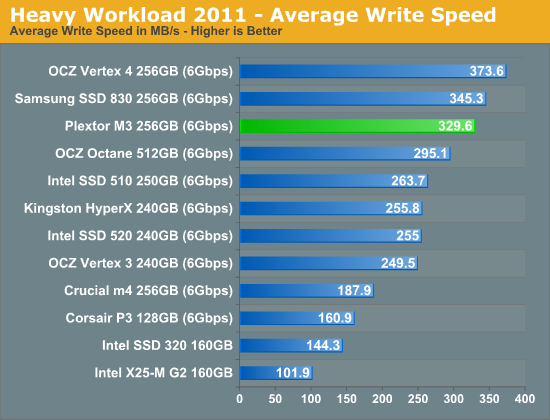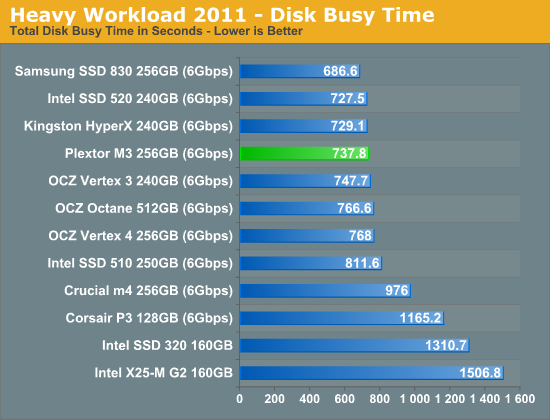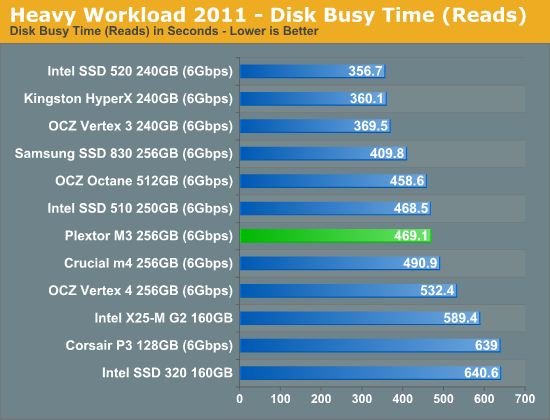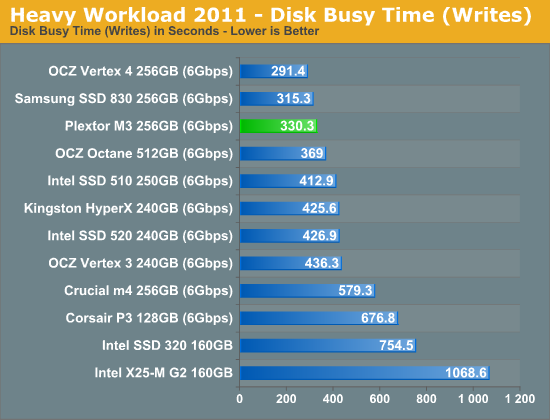The Plextor M3 (256GB) Review
by Kristian Vättö on April 5, 2012 3:05 AM ESTAnandTech Storage Bench 2011
Last year we introduced our AnandTech Storage Bench, a suite of benchmarks that took traces of real OS/application usage and played them back in a repeatable manner. Anand assembled the traces out of frustration with the majority of what we have today in terms of SSD benchmarks.
Although the AnandTech Storage Bench tests did a good job of characterizing SSD performance, they weren't stressful enough. All of the tests performed less than 10GB of reads/writes and typically involved only 4GB of writes specifically. That's not even enough exceed the spare area on most SSDs. Most canned SSD benchmarks don't even come close to writing a single gigabyte of data, but that doesn't mean that simply writing 4GB is acceptable.
Originally we kept the benchmarks short enough that they wouldn't be a burden to run (~30 minutes) but long enough that they were representative of what a power user might do with their system. Later, however, we created what we refer to as the Mother of All SSD Benchmarks (MOASB). Rather than only writing 4GB of data to the drive, this benchmark writes 106.32GB. This represents the load you'd put on a drive after nearly two weeks of constant usage. And it takes a long time to run.
1) The MOASB, officially called AnandTech Storage Bench 2011—Heavy Workload, mainly focuses on the times when your I/O activity is the highest. There is a lot of downloading and application installing that happens during the course of this test. Our thinking was that it's during application installs, file copies, downloading, and multitasking with all of this that you can really notice performance differences between drives.
2) We tried to cover as many bases as possible with the software incorporated into this test. There's a lot of photo editing in Photoshop, HTML editing in Dreamweaver, web browsing, game playing/level loading (Starcraft II and WoW are both a part of the test), as well as general use stuff (application installing, virus scanning). We included a large amount of email downloading, document creation, and editing as well. To top it all off we even use Visual Studio 2008 to build Chromium during the test.
The test has 2,168,893 read operations and 1,783,447 write operations. The IO breakdown is as follows:
| AnandTech Storage Bench 2011—Heavy Workload IO Breakdown | ||||
| IO Size | % of Total | |||
| 4KB | 28% | |||
| 16KB | 10% | |||
| 32KB | 10% | |||
| 64KB | 4% | |||
Only 42% of all operations are sequential; the rest ranges from pseudo to fully random (with most falling in the pseudo-random category). Average queue depth is 4.625 IOs, with 59% of operations taking place in an IO queue of 1.
Many of you have asked for a better way to really characterize performance. Simply looking at IOPS doesn't really say much. As a result we're going to be presenting Storage Bench 2011 data in a slightly different way. We'll have performance represented as Average MB/s, with higher numbers being better. At the same time we'll be reporting how long the SSD was busy while running this test. These disk busy graphs will show you exactly how much time was shaved off by using a faster drive vs. a slower one during the course of this test. Finally, we will also break out performance into reads, writes, and combined. The reason we do this is to help balance out the fact that this test is unusually write intensive, which can often hide the benefits of a drive with good read performance.
There's also a new light workload for 2011. This is a far more reasonable, typical every day use case benchmark. It has lots of web browsing, photo editing (but with a greater focus on photo consumption), video playback, as well as some application installs and gaming. This test isn't nearly as write intensive as the MOASB but it's still multiple times more write intensive than what we were running last year.
We don't believe that these two benchmarks alone are enough to characterize the performance of a drive, but hopefully along with the rest of our tests they will help provide a better idea. The testbed for Storage Bench 2011 has changed as well. We're now using a Sandy Bridge platform with full 6Gbps support for these tests.
AnandTech Storage Bench 2011—Heavy Workload
We'll start out by looking at average data rate throughout our new heavy workload test:

Samsung SSD 830 continues to dominate our Heavy suite but in both read and write, but the M3 is the fastest Marvell based SSD and delivers a result 32% faster than the Crucial m4. Overall the M3 is on-par with SandForce—it does worse in read speed but takes that back in write speed.


The next three charts just represent the same data, but in a different manner. Instead of looking at average data rate, we're looking at how long the disk was busy for during this entire test. Note that disk busy time excludes any and all idles; this is just how long the SSD was busy doing something:













113 Comments
View All Comments
Kristian Vättö - Sunday, April 8, 2012 - link
Then the thanks should go to the man himself, aka Anand :-)wvh - Thursday, April 5, 2012 - link
We're not criticising him, just teaching him the smell of old farts.tnicks - Thursday, April 5, 2012 - link
Yep. I remember getting one of the first 2x burners back in the day from Plextor for ~$450 dollars. I still have nightmares of buffer underrun errors turning my $10/ea dollar blank cds into coasters.The0ne - Thursday, April 12, 2012 - link
Yep. Their products back then were high quality but came at a cost. To give an example, I tested and qualify Plextor CD/DVD drives for use in our system entirely despite the cost. That's how good and reliable they were.I am, however, shocked that the review started off about not knowing about the company though. Plextor has been around for ages with good products, although their presence has been little here in the US. I imagine most that don't know about the company would be young in age, very young.
Impulses - Thursday, April 5, 2012 - link
Will you guys be keeping this drive in a production system to see how it does long term?Kristian Vättö - Thursday, April 5, 2012 - link
I'm using it as a boot drive in my main system at the moment. So far so good.ac2 - Friday, April 6, 2012 - link
Kristian, you say correctly say "64GB and 128GB capacities are often the most popular capacities right now"And yet AT continues to persist with reviews of 200GB and up drives in almost all instances... It may be what the manufacturers are sending you but we expect better...
iwod - Thursday, April 5, 2012 - link
I thought there is a New Marvell controller coming out soon?Kristian Vättö - Thursday, April 5, 2012 - link
Marvell announced the 88SS9187 a couple of weeks ago but it will take a while before manufacturers release SSD based on it.bji - Thursday, April 5, 2012 - link
Marvell is right across the street from me. Well, across the highway anyway. When I ride my bike to work I go through their campus.A year or two ago I was thinking how exciting the SSD controller concept was; I thought that there must be lots of neat algorithmic tricks that can be played to hide the performance issues with block-erase flash memory and it sounded like a very intruiging problem to work on.
Too bad I didn't realize that Marvell would be working on SSD controllers (although I suspected they might). I should have popped across the highway and seen if I could get a job ... although, being a software developer with little experience in embedded controllers, it's unlikely they would have been interested.